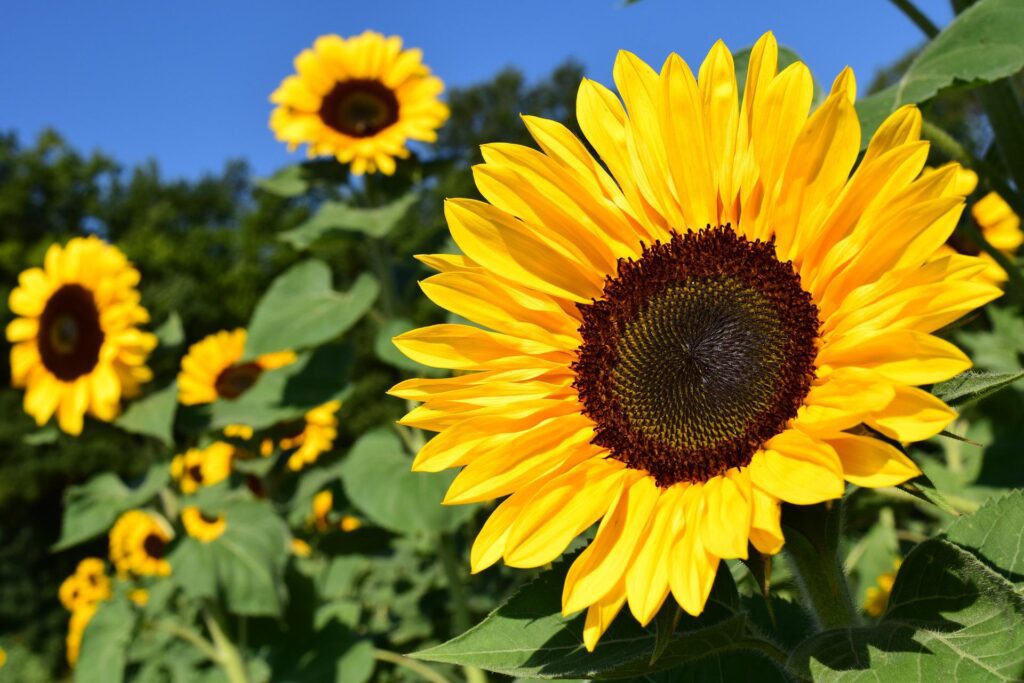Sunflower Farming: How to Plant and Care
Helianthus, where the term, ‘Helios’ means ‘Sun’ and the term ‘Anthus’ means ‘Flower’, gives the name Sunflower. Sunflower is one of the most popular crops in the world. Grown all over the world, especially in the temperate area, the sunflower remains one of the most popular oilseeds in the world. Sunflowers rank as the most important source of vegetable oil.
Oil, being one of the most demanded products in the world, makes sunflower farming very popular and also profitable. Sunflower oil is much more preferred in comparison to other vegetable oils. Sunflower oil is very healthy as it is filled with nutrients. Thus, sunflower oil is widely preferred everywhere and by everyone. This is the reason that sunflower farming is a very profitable business. Since sunflower oil is always in demand, sunflower farming is an occupation that is thriving and growing significantly. With a few methods and some knowledge, sunflower farming could be done successfully.

Climate required in sunflower farming
Like most plants, sunflowers require certain climatic conditions for them to thrive better. These climatic conditions are necessary for the growth of the plant and ultimately for the production of sunflower oil. The sunflowers, in their time of germination, require a lower temperature. The sunflowers need a cool climate when their seedlings are developing and germinating.
The seedlings thrive best under cold temperatures and can also thrive during frost. Seedlings can grow and continue to survive frost. This is possible until the seedlings reach the four to six leaves stage. Once, the seedlings bear around four to six leaves, they require a warmer temperature. The sunflowers from this stage, till the stage they flower will require warm temperatures.
They require warm temperatures accompanied by sunlight until they flower and reach maturity. This warm and hot temperature is absolutely necessary for their growth and development. However, sunflowers do not respond well to heavy humidity. In case of high humidity, the sunflowers may experience a setback in their growth process. Once all the climatic conditions are fulfilled, the sunflowers can be expected to develop well and mature successfully.
Nature of sunflowers
Sunflowers are mostly considered Kharif crops. But, sunflowers can actually be grown in all seasons. Sunflowers are sensitive to the sun’s rays, that is, sunflowers are photo-sensitive in nature. They respond and mature according to the sun’s rays. It is because of this reason that sunflowers can be grown in any season. However, the time duration taken to mature may differ from one season to another. In case the sunflower is treated as a Kharif crop, it would take around 90 days for the sunflower to mature fully.
In case the sunflower is treated as a rabi crop, it would take around 130 days to reach maturity. Sunflowers, being photo-sensitive can also be planted in the spring. When planted during spring, the sunflowers could take around 200 days to successfully mature. This is a unique feature of sunflowers. They do not require any specific season to grow. They can be grown at all times because of their photo-sensitive nature.
Soil required in sunflower farming
Sunflowers require some kinds of conditions to be fulfilled regarding the soil on which they are grown. This is only to ensure that the sunflowers have a high rate of success. However, sunflowers can be grown on a wide range of soil. This feature of the sunflower makes it a very popular crop and is thus, grown all over the world. The pH value of the soil must be in a moderate range.
PH ranging from around 6.5 to 8.5 serves as the best condition for sunflower farming. Thus, with the help of certain fertilizers, the pH value could be added or removed from the soil. The soil could also be slightly saline in nature to promote the growth of the sunflowers. The best kind of soil for sunflower farming is loamy soil. Thigh sunflowers can usually thrive under many kinds of soil, they do best in the case of loamy soils. The soil ought to be well drained.
Water clogging and excessive water are harmful to the sunflowers. Thus, good drainage must be maintained at all costs. Black soil also ensures great success in the case of sunflower farming. Thus, choosing and readying the soil for sunflower farming is an essential part as it ensures the success rate of the sunflowers.
Cultivation of sunflowers
Before beginning the first process of cultivation, the land has to be prepared and be made ready for the sunflower to grow in. the land has to be well moisturized so that the sunflowers get their required source of water. The farmland also has to ensure that there are no weeds present. Weeds are a nuisance to sunflower farming and cause great trouble.
Thus, it is of utmost necessity to ensure that the land is weed free before the process of cultivation. There must be plowing done at least more than once in order to ensure successful growth. Plowing for the first time can be done by moldboard plow. Two or more plowing can be further done. This could be done by the local plow. This could be followed by the process of planking. In order to ensure successful germination of the sunflower seeds, there has to be moisture. Thus, the soil must be watered enough to hold in moisture, which would aid in germination.
Sometimes, a few sunflower seeds may have a thick hull. In these cases, germination becomes difficult. Thus, ample water has to be provided. These are the conditions to be observed while cultivating sunflower seeds.
See Also: Tulip Farming
Sowing in sunflower farming
The seeds must be fertile and healthy in order to ensure proper growth of the sunflower. Thus, care and preparation are required. The sunflower seeds must be treated with Captain or Ceresan at the rate of 3 grams per kg of seeds. This would help in increasing the fertility of the seed and ensure the success rate for germination. The seeds used for growing sunflowers must be of good quality.
They must be certified seeds. The seed rate of around 10 kgs is a necessity to ensure a good harvest and a good yield. The sunflowers while planted ought to have sufficient space in between them. Only when the sunflowers have enough space in between them, they can grow well without disturbing other plants or without getting disturbed. Thus, a minimum of 20 cm is needed between these plants. This would ensure better growth and a higher yield.
The sunflower seeds, while cultivated, must be put in separate holes in the ground, which are dug prior. These holes must have a minimum depth of around 2 cm. the depth can go up to even 3 cm. this would ensure that the seeds have a better stand and that they have a better stand. Thus, these seeds can grow better. The seeds would germinate in a few days.
Around 0 days after cultivating, the seeds would begin to germinate and start showing growth. There will be many instances where there are multiple germinations. In this case, all the extra plants ought to be removed. This is necessary as it prevents crowding and gives enough space for the growth of one single plant. This would also prevent unwanted weeds and unwanted use of energy. Thus, these are the measures that ought to be borne in mind while sowing sunflower seeds.
Irrigation in sunflower farming
Irrigation plays a huge part in any kind of farming. Too much water or too little water will result in bad crops and a poor yield. Thus, irrigation has to be paid utmost attention to. As sunflower is a Kharif crop, not much importance is attached to irrigation. However, irrigation becomes a must when one aims for better yield. In cases of areas where sunflower farming is done and faces scanty and uneven rainfall, irrigation is a must. In such cases, irrigation can be done at specific intervals.
This would ensure that the plants grow and develop well. Irrigation could be done thrice. The 45th day after sowing could be the best time to carry out the first irrigation. The 75th day after sowing is the best time for the second set of irrigation. The last day of irrigation could be done on the 110th day. These three sets of irrigation could be more than enough for the growth of the sunflowers and a good yield.
Sunflowers are also as sensitive to water as they are sensitive to light. Their demand for water may increase between the flowering stage and the grain-filling stage. This is a very crucial stage as this is what determines the yield. As the sunflower seeds are the ultimate product, it cannot be denied that this stage stands as the most important stage in the process of sunflower farming.
Thus, one set of irrigation may be provided in this stage. This can be done only if the sunflowers do not seem to be responding well. Then this irrigation could revive the sunflowers and result in good yield. Such irrigation to ensure grain filling must generally be given in the evenings. This prevents water clogging. This also ensures that the plant uses the water and that the water is not evaporated. It is also critical to keep the plants alive during summer.
During summer the need for irrigation increases even more. This stage demands even more attention on irrigation. In case the natural rains fail and the flowers and plants seep to droop, irrigation may be done. This kind of irrigation could be done in the afternoon. As the afternoon is the hottest of the day, irrigation could provide relief to the plants and ultimately help in their development. Irrigation is thus vital in increasing the yield of sunflowers.
Harvesting in sunflower farming
Like most plants, sunflowers also indicate when it is time for harvest. Sunflowers indicate their time for harvest by using their seeds. When the moisture in the seeds falls below 20 percent, it is time for the harvesting process to begin. The heads indicate that they are ripe when the back of the heads turn yellowish brown.
This indicates the arrival of harvesting. However, not all heads turn yellowish brown at the same time. On average when most of the heads are yellowish brown they could be harvested. The harvesting could be done in installments of 3 times in order to prevent shattering. Once the seeds are harvested it is of utmost importance to dry the seeds in the sun. then the seeds must undergo the process of threshing, where the heads of the seeds are beaten with a stick.
In the case of economical farming, mechanical threshers can be used. The seeds once threshed ought to be dried well in the sun again. Later, they can be stored or can be processed into oil. This completes the process of sunflower harvesting. These steps ought to be borne in mind while harvesting sunflower seeds.
Conclusion
As sunflowers are in heavy demand in the market, there is always scope for sunflower farming. With the proper ideas of sowing, caring, irrigating, and harvesting, sunflower farming could be very successful. Sunflower farming could also bring in a high yield. Sunflower farming could bring in huge profits, as sunflower oil is one of the most demanded products in the world. Sunflower farming with a few technologies and proper methods could result in a high yield and ultimately a good rate of profit.

